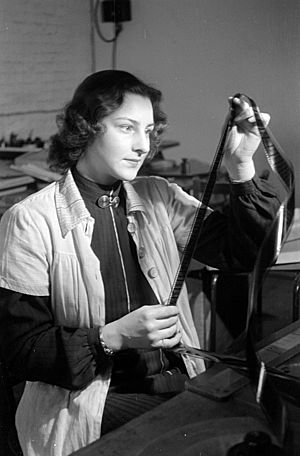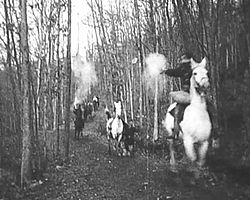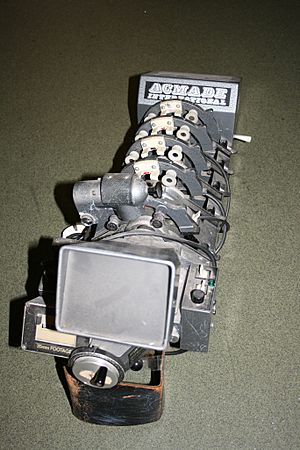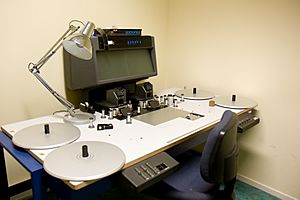Film editing facts for kids
Film editing is a super important part of making movies! It's where all the raw video clips, called footage, are put together to tell a story. Think of it like building with LEGOs: you have lots of different bricks (shots), and the editor decides how to connect them to make something amazing. This job mixes creativity with technical skills, and it usually happens after all the filming is done.
The film editor takes all the video clips and chooses the best ones. Then, they arrange these clips into sequences to create the finished movie. Film editing is often called the "invisible art." Why? Because when it's done really well, you get so caught up in the story that you don't even notice the editor's work! It just feels natural and exciting.
Editors don't just cut and paste clips. They work with many layers: the images, the story, the talking (dialogue), the music, and how fast or slow the movie feels (pacing). They also make sure the actors' performances shine. It's like they "rewrite" the film to make it all fit together perfectly. Editors pick the best shots and remove anything unnecessary to make each scene clear. Sometimes, famous directors like Steven Soderbergh even edit their own films!
Contents
How Editors Shape a Film
Editors have a lot of control over how a film looks and feels. They work with four main things when putting shots together:
Graphic Relations: Making Shots Look Good Together
This is about how two shots look next to each other. Editors pay attention to things like light and dark areas, shapes, and colors. They make sure the look of one shot flows well into the next. For example, they might keep the overall brightness similar or make sure important things stay in the middle of the screen. They can also use color differences to create a certain mood.
Rhythmic Relations: Setting the Film's Beat
The rhythm of a film is how long each shot stays on screen. A short shot can make something feel sudden or exciting, like a quick flash. A longer shot can give you time to react or focus on an action. Editors control the film's "beat" by changing how long each shot lasts. They can make the film feel fast-paced or slow and calm, depending on the story.
Spatial Relations: Building the World of the Film
Editing helps create the space of the film. Even if different parts of a scene are filmed in different places, the editor can make it look like they are all connected. For instance, they might show a wide shot of a room, then cut to a close-up of something in that room. This helps you understand where everything is and how it fits together.
Temporal Relations: Playing with Time
Editors can change how time works in a movie. They can make events happen in a different order, show flashbacks (looking back in time), or flash-forwards (looking ahead). They can also make an action seem shorter or longer than it really was. This gives filmmakers the power to control the story's timeline and how the audience experiences it.
By using these four ways of connecting shots, editors add a lot of creativity to a film. They make the movie more exciting and help you feel more connected to the story.
The Editor's Evolving Role
In the past, film editors mostly worked only with the picture. Other people handled the sound, music, and special effects. But now, with non-linear editing systems (digital tools), editors often do much more! Especially on smaller films, they might add temporary music, create simple visual effects, or put in sound effects. This makes the editor's job even more important for a film's success.
History of Film Editing
Early films were very simple. They were just one long, still shot, like a camera recording traffic on a street. There was no story and no editing. The film just ran until it ran out!
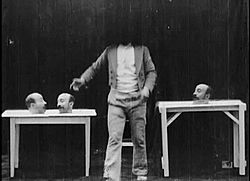
The first film to use editing was Come Along, Do! in 1898 by Robert W. Paul. It used different shots put one after another to tell a simple story. Over time, directors started using editing in more creative ways. For example, director Wes Anderson often uses very symmetrical shots and unique colors in his films, which is part of his editing style.
British filmmakers like Robert W. Paul, George Albert Smith, and James Williamson were pioneers in editing. They figured out how to make actions flow smoothly from one shot to the next. They also experimented with close-ups and special effects.
Then came American filmmaker Edwin Stanton Porter. In 1903, he made Life of an American Fireman, which was one of the first American films with a real plot. His film The Great Train Robbery (1903) was even more important. It was 12 minutes long with 20 different shots and many locations. Porter used a technique called cross-cutting to show things happening at the same time in different places.
These early filmmakers discovered something huge: you don't need to show a whole person from head to toe, and putting two shots together makes your brain connect them. This meant filmmakers could shoot scenes in different places and at different times, then combine them to create a full story. For example, in The Great Train Robbery, when the robbers leave a building and then appear at a water tower, the audience believes they went straight from one to the other.
Around 1918, a Russian director named Lev Kuleshov did a famous experiment called the Kuleshov Experiment. He showed people a shot of an actor's face, then cut to a bowl of soup, then to a child playing, then to a dead woman. People thought the actor's face showed hunger, delight, or grief, depending on what was shown next. But the actor's face was the same in all cases! This showed that simply putting shots next to each other creates meaning in the viewer's mind.
Film Editing Technology Over Time
Before computers, editors cut films by hand! They used a positive copy of the film called a workprint. They would physically cut strips of film and tape or glue them together. This was very precise work, and mistakes were costly.
Then came machines like the Moviola and "flatbed" editors like the Steenbeck. These machines made editing faster and more accurate. Editors could make choices more quickly, which was great for TV shows that had tight deadlines.
Today, most films are edited digitally using computer programs like Media Composer, Final Cut Pro X, or Premiere Pro. This is called non-linear editing. It's like having all your film clips on a computer hard drive, so you can easily move them around, try different edits, and play them back instantly without damaging the original film. Digital editing is also cheaper and more efficient.
Another important digital tool is color grading. This is where editors change or improve the colors in a film. They can make a scene look warm and sunny, or cold and gloomy, to match the mood of the story. Color grading helps make the film look even better and stronger.
Women in Film Editing
In the early days of film, editing was seen as a technical job, not a creative one. Because of this, many women found opportunities in editing, even though other creative roles like director or cinematographer were usually given to men. Editing allowed creative women to make their mark on filmmaking. There have been many important women editors throughout film history, like Dede Allen and Anne V. Coates.
Post-Production: The Editing Journey
After filming is done, the movie goes into post-production, which includes editing. There are three main stages of editing:
The Editor's Cut
This is the very first version of the film put together by the editor. The editor often starts working while filming is still happening. They look at the "dailies" (the raw footage shot each day) to get an idea of what the director wants. This first cut might be longer than the final movie. It's the editor's chance to shape the story and show their vision of how the film should unfold.
The Director's Cut
Once filming is finished, the director works closely with the editor to refine the film. They go through every scene, moving things around, cutting parts out, or making them shorter. Sometimes, they even find plot holes or realize they need to film new scenes! This close teamwork often creates a strong artistic bond between the director and editor. The goal is to make sure the film matches the director's artistic vision.
The Final Cut
After the director's cut, producers (who represent the film studio) often get involved. They might ask for more changes. The final cut is the very last version of the film. It's the one that will be shown to everyone in theaters or on streaming services.
Mise en Scene vs. Editing
Mise en scene is a French term that means "everything in the scene." It includes all the things you see in a shot, like the lighting, costumes, props, and how things are placed. Film editing and mise en scene work together. For example, an editor might use filters or adjust the lighting (part of editing) to enhance the mood that the mise en scene (like a dark set or a bright costume) has already created.
Montage: Putting Shots Together for Meaning
A montage is an editing technique where many short shots are put together quickly. It comes from a French word meaning "assembly."
There are a few ways to think about montage:
- In French films, "montage" just means editing.
- In Soviet filmmaking (like in the 1920s), "montage" was about putting shots together to create new ideas or feelings that weren't in the individual shots.
- In Hollywood movies, a "montage sequence" is a short part of a film that quickly shows a lot of information, often to show time passing. A song usually plays in the background.
D. W. Griffith was an early director who understood the power of editing. He mastered cross-cutting to show actions happening at the same time in different places.
Lev Kuleshov believed that editing was what made cinema unique. He thought editing a film was like building a house, brick by brick (shot by shot). His Kuleshov Experiment showed that putting shots together can make viewers think certain things.
Sergei Eisenstein, another Russian filmmaker, believed that contrasting different shots could create new meaning. He thought that putting two opposite shots together would create a "shock" that would make the viewer think deeply. He even saw this idea in Japanese writing and poetry!
A common example of a montage sequence in Hollywood is a "sports montage." This shows an athlete training hard over time, with each shot showing more improvement. Think of the training scenes in Rocky or The Karate Kid!
Continuity Editing
Continuity editing was developed in the early 1900s to make films flow smoothly and logically. It makes sure that things stay consistent from one shot to the next. For example, if a character is wearing a blue shirt in one shot, they should still be wearing a blue shirt in the next shot of the same scene. This helps the audience stay focused on the story without getting confused.
Filmmakers like David Wark Griffith helped create the "classical Hollywood" style of continuity editing. This style uses techniques like the 180 degree rule (keeping the camera on one side of the action) and Shot reverse shot (showing one person talking, then the other). These rules help keep the audience from getting lost in the film's space.
Sometimes, editors might make small "jumps" in time or space that you don't even notice. For example, a character walking across a room might "skip" a few steps between cuts, but the editing makes it look continuous so you aren't distracted.
Some filmmakers, like those from the French New Wave in the 1950s and 60s, liked to break these rules. They used jump cuts and other techniques that made the audience more aware they were watching a film. This was a more experimental style.
Why Film Editing Matters So Much
Vsevolod Pudovkin, a filmmaker, said that editing is the only part of making movies that is truly unique to film. Other parts, like photography or writing, come from other art forms. But editing is special to cinema.
Filmmaker Stanley Kubrick once said, "I love editing. I think I like it more than any other phase of filmmaking." He meant that everything before editing is just preparing the film to be edited!
Film editing is super important because it shapes the story, how the film looks, its rhythm, and how it makes you feel. Editors have amazing creative power to arrange shots and bring stories to life on screen. It's a true art form within filmmaking!
Assistant Editors: The Unsung Heroes
Assistant editors are like the editor's right-hand person! They help gather and organize all the video clips, sound files, music, and special effects needed for editing. They make sure everything is labeled, logged, and stored neatly so the editor can find it easily.
On big movie sets, there might be a whole team of assistants. The first assistant editor leads this team and might even do some small editing tasks. Assistant editors also help connect the editing team with other departments, like sound designers or visual effects artists. They often put in temporary sound or music until the final versions are ready.
Assistant editors are like database managers for the film. They keep track of all the numbers and timecodes for every piece of footage and sound. When the editor finishes their cut, the assistant editor makes sure all the high-quality original elements are put back together correctly for the final film.
Being an assistant editor is a great way to learn the ropes and eventually become an editor. Many assistants have long and rewarding careers helping to create amazing films and TV shows!
See also
 In Spanish: Montaje para niños
In Spanish: Montaje para niños
- 180-degree rule
- 30-degree rule
- Footage (A Roll)
- B-roll
- Cinematic techniques
- Clapperboard
- Compositing (keying)
- Cut (transition), for the director's call Cut! or stop
- Axial cut
- Cross-cutting
- Fast cutting
- Jump cut
- Long take
- Match cut
- Slow cutting
- Cutaway
- The Cutting Edge: The Magic of Movie Editing
- Edit decision list (EDL)
- Film transition
- Dissolve
- L cut (split edit)
- Wipe
- Filmmaking
- Index of articles related to motion pictures
- Kuleshov effect
- Motion Picture Editors Guild (MPEG)
- Moviola
- Negative cutting
- Outline of film
- Re-edited film
- Scene
- Sequence
- Shot
- Crane shot
- Establishing shot
- Insert
- Master shot
- Point-of-view shot
- Shot reverse shot
- Video editing


